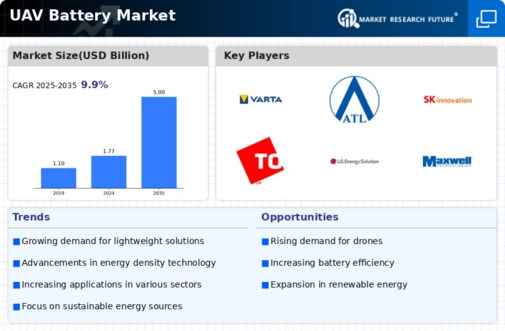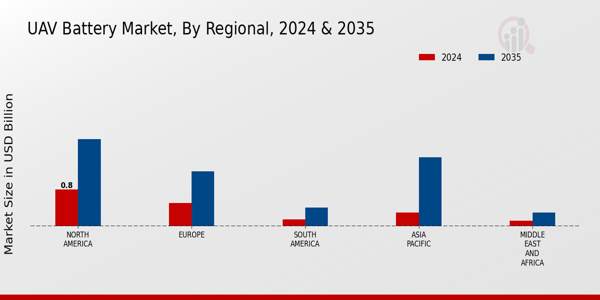Market Share
Introduction: Navigating the Competitive Landscape of UAV Battery Innovation
The UAV battery market is experiencing unprecedented competitive momentum, driven by rapid technology adoption, evolving regulatory frameworks, and heightened consumer expectations for performance and sustainability. Key players, including OEMs, IT integrators, and infrastructure providers, are vying for leadership by leveraging advanced technologies such as AI-based analytics and IoT integration to enhance battery efficiency and lifecycle management. Meanwhile, emerging disruptors, particularly green technology startups, are reshaping the landscape with innovative solutions that prioritize environmental sustainability. As regional growth opportunities expand, particularly in North America and Asia-Pacific, strategic deployment trends are increasingly focused on automation and smart infrastructure, positioning companies to capitalize on the demand for high-performance UAV systems. In this dynamic environment, understanding the interplay of these factors will be crucial for C-level executives and strategic planners aiming to secure a competitive edge in the UAV battery sector.
Competitive Positioning
Full-Suite Integrators
These vendors provide comprehensive battery solutions, integrating advanced technologies for UAV applications.
| Vendor | Competitive Edge | Solution Focus | Regional Focus |
|---|---|---|---|
| LG Energy Solution | Strong R&D capabilities | Lithium-ion batteries | Global |
| Samsung SDI | Innovative battery technology | Lithium-ion batteries | Global |
| Contemporary Amperex Technology Co, Ltd | High-performance battery solutions | Lithium-ion batteries | Asia, Europe, North America |
Specialized Technology Vendors
These companies focus on niche battery technologies, offering specialized solutions for UAVs.
| Vendor | Competitive Edge | Solution Focus | Regional Focus |
|---|---|---|---|
| A123 Systems | Advanced lithium iron phosphate technology | Lithium batteries | North America, Europe |
| Maxwell Technologies | Ultracapacitor technology integration | Energy storage solutions | Global |
| VARTA AG | Compact and efficient battery designs | Rechargeable batteries | Europe, North America |
Infrastructure & Equipment Providers
These vendors supply the necessary infrastructure and equipment to support UAV battery technologies.
| Vendor | Competitive Edge | Solution Focus | Regional Focus |
|---|---|---|---|
| EnerSys | Comprehensive energy solutions | Industrial batteries | Global |
| Panasonic | Diverse battery technologies | Lithium-ion and other batteries | Global |
| SK Innovation | Strong supply chain integration | Battery manufacturing | Asia, Europe, North America |
Traditional Battery Manufacturers
Established players in the battery market, focusing on proven technologies for UAV applications.
| Vendor | Competitive Edge | Solution Focus | Regional Focus |
|---|---|---|---|
| Hitachi Chemical | Long-standing industry experience | Chemical batteries | Asia, North America |
| Amperex Technology Limited | High-capacity battery solutions | Lithium-ion batteries | Asia, Europe |
| Saft Groupe | Expertise in specialized battery systems | Industrial batteries | Global |
Emerging Players & Regional Champions
- Quantum Battery Technologies (USA): Specializes in high-density lithium-sulfur batteries for UAVs, recently secured a contract with a major drone manufacturer for a new delivery service, challenging established vendors by offering longer flight times and reduced weight.
- Energid Technologies (Canada): Focuses on smart battery management systems that enhance UAV performance, recently implemented their technology in a fleet of agricultural drones, complementing traditional battery suppliers by improving efficiency and lifespan.
- Voltaic Systems (USA): Offers solar-integrated battery solutions for UAVs, recently partnered with a logistics company for sustainable drone operations, positioning themselves as a green alternative to conventional battery solutions.
- AeroVironment (USA): Known for their hybrid battery systems that combine fuel cells with traditional batteries, recently expanded their product line for military UAVs, challenging existing military suppliers by enhancing operational range and endurance.
- Batteries Plus (USA): Provides customizable battery packs for various UAV applications, recently launched a rapid prototyping service for drone manufacturers, complementing established vendors by offering tailored solutions for niche markets.
Regional Trends: In 2024, the UAV battery market is witnessing significant regional adoption, particularly in North America and Europe, driven by advancements in battery technology and increasing demand for drone applications in logistics, agriculture, and surveillance. There is a notable trend towards hybrid and sustainable battery solutions, with companies focusing on enhancing energy density and reducing environmental impact. Additionally, the integration of smart battery management systems is becoming a key specialization, allowing for improved performance and longevity of UAVs.
Collaborations & M&A Movements
- Tesla and Panasonic expanded their partnership to co-develop advanced lithium-ion battery technologies specifically for UAV applications, aiming to enhance energy density and reduce costs, thereby strengthening their competitive positioning in the UAV battery market.
- Northrop Grumman acquired a minority stake in QuantumScape to leverage their solid-state battery technology for UAVs, which is expected to significantly improve flight times and operational efficiency, positioning Northrop Grumman as a leader in next-generation UAV solutions.
- LG Chem entered into a collaboration with DJI to supply high-performance battery packs for their UAVs, focusing on increasing flight duration and reliability, which is anticipated to enhance LG Chem's market share in the UAV battery segment.
Competitive Summary Table
| Capability | Leading Players | Remarks |
|---|---|---|
| Energy Density | DJI, Parrot | DJI has developed high-energy density batteries that allow for longer flight times, evidenced by their Mavic series, which can achieve up to 31 minutes of flight on a single charge. Parrot's Anafi series also showcases advancements in energy density, enabling extended operational capabilities. |
| Charging Speed | Yuneec, Skydio | Yuneec's rapid charging technology allows their batteries to recharge to 80% in under an hour, significantly reducing downtime. Skydio has implemented fast-charging solutions in their drones, enhancing operational efficiency for commercial users. |
| Battery Lifecycle | AeroVironment, Teledyne FLIR | AeroVironment's batteries are designed for extended lifecycle, with over 500 charge cycles, making them ideal for military applications. Teledyne FLIR emphasizes durability and lifecycle in their UAV batteries, which are tested for harsh environments. |
| Weight Optimization | Wingtra, senseFly | Wingtra's batteries are engineered for lightweight performance, allowing for increased payload capacity and flight efficiency. senseFly focuses on minimizing battery weight while maximizing performance, which is critical for mapping and surveying applications. |
| Sustainability | EHang, Volocopter | EHang is pioneering sustainable battery technologies, including recyclable materials in their UAV batteries. Volocopter is also focusing on eco-friendly battery solutions, aligning with their vision for urban air mobility. |
Conclusion: Navigating the UAV Battery Market Landscape
The UAV Battery Market in 2024 is characterized by intense competitive dynamics and significant fragmentation, with both legacy and emerging players vying for market share. Regional trends indicate a growing emphasis on sustainability and innovation, particularly in North America and Europe, where regulatory frameworks are increasingly favoring eco-friendly solutions. Vendors are strategically positioning themselves by leveraging advanced capabilities such as AI for predictive analytics, automation for production efficiency, and flexibility in product offerings to meet diverse customer needs. As the market evolves, leadership will be determined by those who can effectively integrate these capabilities while also addressing the demand for sustainable practices, thereby ensuring a competitive edge in this rapidly changing landscape.













Leave a Comment